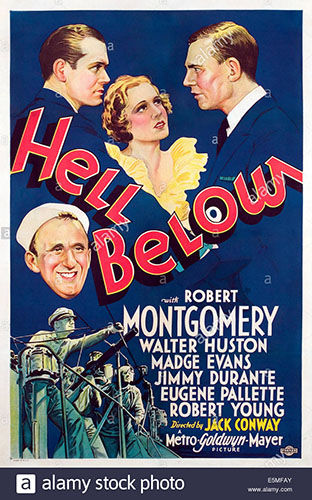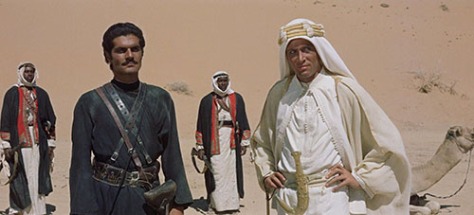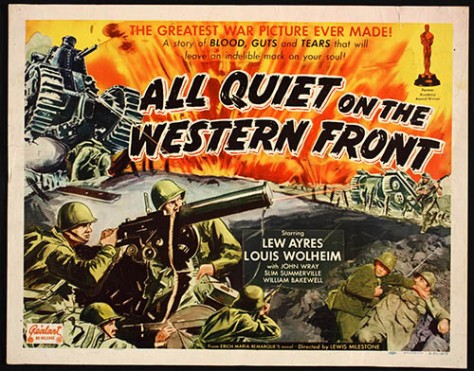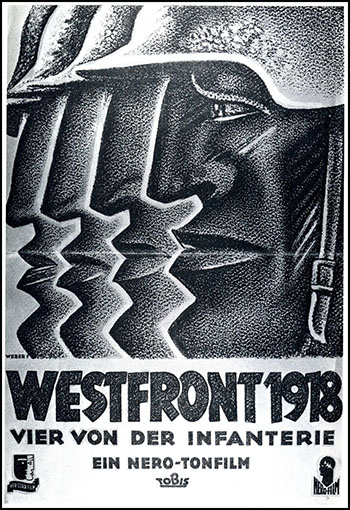Writing about the 2001 tv movie “The Lost Battalion” forced me to think of other movies focused on “the Great War,” which was supposed to be the war to end wars and to make the world safe for democracy. In my view it was a particularly senseless war, entered into with great enthusiasm by Europeans. In the US, Woodrow Wilson was re-elected president on a platform of keeping out the stalemate. Don’t get me wrong: I don’t think it would have been good if Germany had won. The fresh cannon fodder and supplies from the US won the war, but the peace treaties guaranteed future trouble. One instance is the creation of Iraq out of what had been three provinces of the Ottoman Empire. The most obvious one is that Germany launched another war in 1939 and conquered much more of Europe (and Africa) than it had during the First World War. My hindsight is that the Germany that had not been united for long should have been broken up (and a Kurdistan created, and…)
Movies and popular memory — insofar as the two can be separated — are dominated by romantic air duels in single-engine planes (Snoopy and the Red Baron even more than the actual WWI flyers) and the misery of trench warfare. The latter included going “over the top” across barbed wire under heavy fire from machine guns.
By the time the US was mobilized by revelation of the Zimmerman Telegram and the sinking of the (British) Lusitania, the European generals had learned a thing or two about machine guns, but the American ones came still mentally fighting the Civil War with massed infantry charges. The callousness about the lives of ordinary soldiers is the major leitmotif of movies about the WWI ground war. What many consider the best WWI film, Stanley Kubrick’s “Paths of Glory” (1957) and Joseph Losey’s “King and Country” (1964) show a bit of the trench misery, but are mostly court martial trials (for, respectively, refusal to continue an impossible attack and desertion). The stars are the defense lawyers, Kirk Douglas and Dirk Bogarde, respectively. Both movies show the cynicism and lack of interest in the human costs of command decisions. “The Immortal Battalion” has some of this, too, though the operation was a success (and a third of the soldiers were able to walk out after having held a position that was indefensible by any rational calculus). Carnage there was, a lot of it.
Five Congressional Medals of Honor were awarded to leaders of the “lost battalion” (which was right where it was ordered to be, not wandering through the Argonne Forest lost). The most celebrated of WWI American war heroes was Sgt. Alvin York. Gary Cooper won his first Oscar portraying Sgt. York in Howard Hawks’s 1941 biopic of an Appalachian sharpshooting pacifist applying his technique for turkey shoots to capturing a German position (and 132 prisoners). Walter Brennan escalates the hokey hillbilly cliché-mongering, but Cooper makes it mostly work.
Hawks had earlier directed the romance/melodrama “Today We Live” (1933) based on a story by William Faulkner and also starring Gary Cooper, here vying for Joan Crawford with Robert Young. It is very gallant with war offering the loser a gallant exit.

The great WWI submarine movie, “Hell Below” also dates from 1933 (the year Hitler became chancellor of Germany) with Robert Montgomery playing an insubordinate officer of the crusty Walter Huston. Lt. Thomas Knowlton (Montgomery) is in love with his commander’s married daughter (Madge Evans) who must stand by her man when he is badly wounded. If you don’t know the rest, extrapolate from “Today We Live.” Maybe there is a Hollywood WWI leitmotif of death with honor for those who lose in love… BTW, there’s another court martial within “Hell Below.”
And a fickle Jean Harlow was the apex of yet another triangle (well, the flyers were brothers, not just brothers in arms) in Howard Hughes’s “Hell’s Angels” (1930) which is mostly notable for its aerial photography.
William A. Wellman directed “Wings” to the first best-picture Oscar in 1927. It also involves a love triangle (stateside) played by Richard Arlen and for a woman Former “It Girl” Clara Bow, quite demure herein as Mary, is in love with Jack (Buddy Rogers). Jack is in love with cars and does not notice Mary. David (Richard Arlen) does notice and lust after her, but he and Jack become buddies in the Army Air Corps. Mary follows Jack to France (in the Women’s Motor Corp) and there is quite a melodramatic ending.
A comedy version (extending back to earlier armed combat) with rivals bonding (in the US Marines) was Raoul Walsh’s 1926 screen version of Maxwell Anderson’s play “What Price Glory?” with the points of the triangle played by Victor McLaglen, Dolores del Rio, and Edmund Lowe. John Ford remade it in 1952 with James Cagney, Corinne Calvet, and Dan Dailey as the triangle members.
I guess the two 1931 movies about the spy Mata Hari going gallantly to her death, “Mata Hari” with Greta Garbo and “Dishonored” with Marlene Dietrich have to be included. The European-born movie stars show as much sang-froid facing a firing squad as Robert Young and Robert Montgomery did piloting boats on kamikaze missions. Garbo had a better supporting cast (Ramon Novarro, Lionel Barrymore) but Dietrich had Josef von Sternberg at the helm. Also Dietrich was the better dancer.
And the 1947 French triangle in “Le diable au corps” (The Devil in the Flesh) with Gérard Philipe. Jeez! I almost forgot Georges Franju’s adaptation of Jean Cocteau’s Thomas l’imposteur (Thomas, the Impostor, 1965). Maddeningly unavailable on DVD, I still retain images from it after decades. A later (1989) and very good French film, directed by Bertrand Tavernier was “La vie et rien d’autre”/“Life and Nothing But,” starring Philippe Noiret sorting through and trying to identify corpses form the Battle of Verdun. It also out of print.
I am a major admirer of Pat Barker’s Regeneration trilogy. The 1997 movie condensation by Allan Scott (as “Regeneration”) is not bad, just the books are so great. Jonny Lee Miller was quite dashing looking as the fictional working-class lieutenant among the soldier-poets and shellshock-treatment pioneer William Pitt-Rivers (Jonathan Pryce).

My favorite WWI movie is David Lean’s “Lawrence of Arabia” (1962) with a megalomaniac British misfit, T. E. Lawrence (Peter O’Toole) organizing Arabs, being sodomized by a Turkish officer (José Ferrer), and disillusioned when the politicians (Claude Rains et al.) break the promises by which he led Arabs (Omar Sharif, Anthony Quinn, et al.) against the tottering Ottoman Empire. There is action, there is carnage, there is self-disgust and disgust at the conduct of those on Lawrence’s side (Arab and British). The movie also shows press manipulation and celebrity creation (Arthur Kennedy playing Lowell Thomas, making Lawrence a legend). (WWI looms in Lean’s 1965 “Dr. Zhivago,” also starring Omar Sharif, but I don’t consider it a “WWI movie.”)
I’ve been to Gallipoli and seen the narrow beach and high bluff Australian and New Zealand soldiers were thrown onto. I thought that Peter Weir’s 1981 movie “Gallipoli” was good, but it made Mel Gibson a star, which blocks positive memories of the movie, so is not on my list!

Based on the international best-selling anti-war novel by Erich Maria Remarque, “All Quiet on the Western Front” (1930, directed by Lewis Milestone) is remarkable for telling the story of disillusionment of a gung-ho recruit (Lewis Ayres) to the German army. Trench warfare was hell for the Germans as well as for their opponents (the Americans were not technically “Allies” and eventually declared an end of hostilities after the Versailles Treaty was not ratified by the US Senate).

Georg Wilhelm Pabst directed “Westfront 1918” the same year, showing not only the terror of trench warfare, but how bad things are back at home, when the soldier Karl, played by Gustav Diessl, goes back on leave. The small-town German boys do their part without ideology or enthusiasm. It has a near-documentary feel with pioneering sound engineering. And a harrowing tank attack. In Germany the movie was then ferociously criticized from the right for “defeatism” and from the left for failing to provide any indication of how the soldiers came to be in their hopeless position.
The most antiwar of WWI movies was Dalton Trumbo’s “Johnny Got His Gun” (1971) with a harrowing performance from Timothy Bottoms as a soldier who has lost his arms, legs, eyes, ears, mouth and nose, but not consciousness. Among his hallucinations (unfortunately) is Donald Sutherland as Christ. “Gods and Monsters” (1998) was certainly haunted by WWI traumatic memories, and links to “Johnny” (and other movies discussed above) in seeking death without committing suicide. Frank Borzage’s “Three Comrades” (1938, best remembered for supplying F. Scott Fitzgerald’s only screen credit) is mostly postwar. It interestingly involves Germans, including one played by Robert Young. As usual the comrades-in arms (Robert Taylor and Franchot Tone are the other two) are in love with the same woman (this time, a dying Margaret Sullavan).
Another portrayal of the detachment from reality of generals (on both sides) is “Joyeux Noel” in which those languishing in the trenches have a very unsanctioned-from-above Christmas truce. Though conflating several instances, this movie is, like “The Immortal Battalion” and “Sgt. York” based on what actually happened.
Jean Renoir’s classic “Le grande illusion” (Grand Illusion is a prison escape movie, the prisoners being French officers (Jean Gabin, Pierre Fresnay), the POW commandant an honorable Prussia Erich von Stroheim.
The classic airborne gallants movie, “The Dawn Patrol” (1930), starring Richard Barthelmess and Douglas Fairbanks Jr., was directed by Howard Hawks. Though there are several dawn expeditions from which only about half the planes return, Hawks’ movie ends with a dusk suicide mission for one. The movie was remade in 1938 as an Errol Flynn vehicle, directed by Edmund Goulding. Flynn played the Barthelmess part of jaunty, insubordinate flyer promoted to making decisions about sending others out to be shot down.
I have not seen the 1965 German adaptation of Joseph Roth’s esteemed novel The Radetsky March or the 1933 RAF drama “The Eagle and the Hawk” (with Fredric March and Cary Grant) or the 1966 RAF “The Blue Max” with George Peppard and James Mason. More embarrassingly I have not seen more than a clip of King Vidor’s (1925, silent) “The Big Parade” with John Gilbert.
I have seen both screen adaptations of Hemingway’s A Farewell to Arms, but the hospitalized American lieutenant does not flashback to what got him wounded. And I’ve seen the Vivien Leigh/Robert Taylor tearjerker “Waterloo Bridge,” which also is set away from the fighting, so not a “WWI movie.” Ditto for “Cavalcade.” (which I also found exceedingly boring). And the lovin’-the-same woman “Legends of the Fall.”
An actual list? You want a list? OK. But it will be of my favorites, even if headed by what is also the best. (I know that some would accord this to “Grand Illusion” and would press for including “Paths of Glory.”) And four could be challenged as being included among “war movies.”
Lawrence of Arabia
Westfront, 1918
Thomas l’imposteur
Hell Below
Dawn Patrol (the 1930 one)
Joyeux Noel
Le grande illusion
King and Country
Dishonored
Wings
©2017, Stephen O. Murray
I have also posted a list of the best WWII movies and a survey of Korean War movies.
And I wrote about three WWI-set comedies made 50-60 years after the war here.